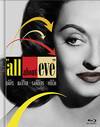|
|
Reel Classics > Films
> Movies > The Little Foxes
(1941) >
The Little Foxes (1941)
Cast | Crew
| Awards | Articles
| Screen Caps Gallery | Bibliography | Links |
Image Credits
Shot Composition in THE LITTLE FOXES
Besides the fascinating characters and storyline, THE
LITTLE FOXES is also famous for its black-and-white cinematography by
cameraman Gregg Toland (who worked on CITIZEN KANE the same year).
An important element of that photography however was director
William Wyler's shot composition -- how he set up a scene and arranged the various
elements (characters, sets, props, etc.) within it.
Wyler's shot
composition in THE LITTLE FOXES is subtle, non-distracting, and even yet,
exceptionally complex. Although the audience doesn't necessarily
notice this while watching the story unfold on film, it becomes apparent
in the collection of screen captures below: |
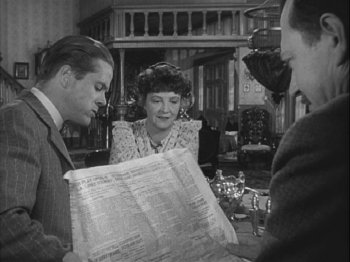
SHOT 1:
This shot of the Hubbard family at breakfast is atypical of
Hollywood films of the time -- or even of films today. Typically, such a shot
would be composed with the table clearly visible in the middle, one
character in a chair on each end, and one in a chair on the back side, with the camera assuming
the point of view of the empty fourth chair. Though the characters may be sitting at the table
quite normally in this shot, the camera is not capturing them from the point of view of
the fourth chair (which would be facing Leo head-on), but rather over the shoulder of Oscar Hubbard. This
permits the characters and the expressions on their faces to fill up the
screen instead of letting the frame be dominated by the table and the space
between the characters in their various positions. |
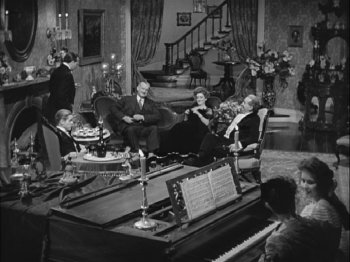
SHOT 2:
This coverage shot of the living room creates three distinct planes of
activity in the room: the piano in the foreground, the settee and chairs in
the center, and the staircase in
the background. (Notice how all three planes are in focus.) Each plane
of activity is its own little world in the context of the scene, and yet, is
still shown in relation to the whole. All the characters and their positions in the
room are clearly visible, yet they don't seem squished together for the
benefit of the camera. This kind of shot composition takes advantage
of the camera's deep-focus capabilities and allows the director to show all
the activity within the scene without cutting back and forth between
separate shots
of different characters or using distracting camera movements to pan back
and forth between certain areas of the scene. |

SHOT 3:
This later shot of the living room scene again comprises three distinct
planes of activity, although they are not the same three as in the previous
coverage shot. The settee and chairs are again a plane (and this time,
the one emphasized in the foreground), while the staircase in the background remains an unused
part of the scene. A new plane of activity has been introduced between
the settee and the staircase however -- that of Aunt Birdie in a chair
against the wall over Regina's right shoulder. Again, this allows the
director to focus on the conversation taking place between Regina and her
brothers, while at the same time, including Aunt Birdie's quiet reactions.
If Wyler had cut away from the conversation to show a close-up of Aunt
Birdie's sullen face, and then cut back to the conversation (as is typical
in such a situation), he would have destroyed the subtlety of this approach. |
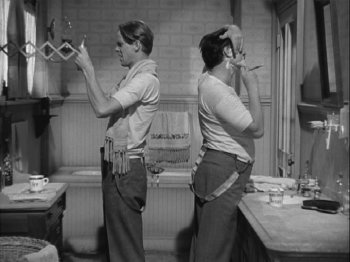
SHOT 4:
One of Wyler's most ingenious shots of the entire film is this shaving
scene between Oscar Hubbard and his son Leo. In the Lillian Hellman play
(on which the film is based), this scene
takes place at the breakfast table over a cup of coffee. But
Wyler
moved it to the bathroom and faced the two men away from each other --
simultaneously showing them to be very similar characters (their parallel
dress and activity), but also a father
and son out of touch with each other. |

SHOT 5:
Again, after establishing the spatial relationship between the characters with
the coverage shot
above (as in the living room scene), Wyler changes angles to better capture the
facial expressions of the actors. Using juxtaposed mirrors, the shot
captures not only the faces of both characters so the audience can see them
at the same time,
but it also captures them from the point of view of the characters themselves.
Thus, the audience sees Oscar and Leo in the same manner in which they are
seeing each other. |
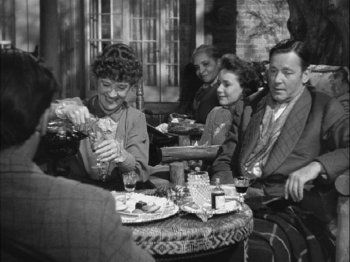
SHOT
6:
Another shot featuring several characters but placing them in different
planes so as not to crowd them together physically. Note how each
character's placement in this shot is a commentary on that character's role
in the scene. The camera is looking over David's shoulder at the
conversation taking place between Aunt Birdie, Alexandra and Horace (the
topical emphasis of the scene). Thus, just as David is essentially an
observer to the scene, so the audience adopts his point of view for its own
observing. Also, just as Addie (in the background plane) interjects
occasional comments into the conversation, so her character is visually
interjected into the scene in the natural space between Alexandra and Aunt
Birdie. |
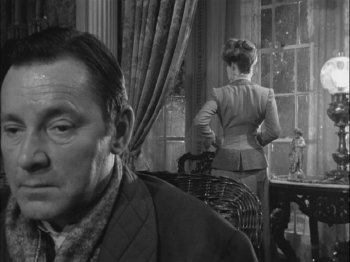
SHOT
7:
Again, two characters conversing while facing away from each other (as
in the shaving scene). In this instance however, only the facial
expressions of one are visible. The malicious nature of Regina's
character has already been established, so it is not important to show the
audience her face in order to demonstrate how she is intending to hurt
Horace with her comments; the audience already understands this.
Instead, this shot composition emphasizes Horace's reaction to the cruel
things Regina is saying to him, revealing the true effect of her words and
providing the basis for the heart attack which is to follow. |
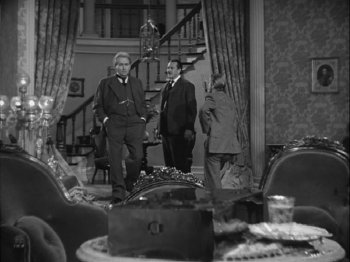
SHOT
8:
Yet again, multiple planes of activity (the stairs, the three men, and
the settee and table), but notice this time how Wyler places Horace's safe
deposit box on the table in the foreground. It is in plain sight, but
just as the audience doesn't immediately notice its presence in the shot,
neither do Ben, Oscar and Leo. It is their discovery of the box which
prompts a dramatic change of course in both the plotline and the mood of the
scene, and thus, the safe deposit box's key role in the course of events is emphasized by its central
placement in the shot. |
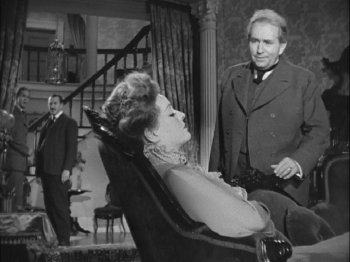
SHOT
9:
Again the multiple planes, this time emphasizing how Regina has suddenly
become the center of attention (because she knows Leo stole the bonds and is
prepared to prosecute him). Also, forced into the secondary plane,
Oscar and Leo (now that their plotting has been discovered) have lost their
equal status in the family as well as in the shot. Ben joins Regina in
the foreground because he is the only one worthy of her attention. |
|
Go to the next page.
Gallery 1 | Gallery 2 |
Gallery 3 |
|
|















![]() Printer-friendly version.
Printer-friendly version.
![]() Return
to the top.
Return
to the top.




